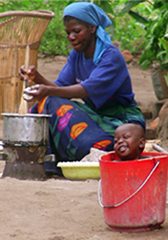What is the Livelihood Improvement Approach?

The livelihood improvement approach is a technique that developed to improve the lives of people in rural Japan particularly in the late 1940s and 1950s before the nation entered its period of high economic growth. The farming sector in Japan had the same sorts of problems that many developing countries face today in areas such as daily living, sanitation and health. An important characteristic of the livelihood improvement approach is its way of solving issues not by introducing foreign systems and technologies, but by skillfully using the limited resources available to improve people's lives. Under this approach, the problems that needed to be solved were identified, and the rural residents took possession of the activities to devise and implement solutions.
The Efforts and Results in Japan
The women in rural communities came together and formed groups, discussing the problems and needs they had in their lives. Over time, working groups developed to work in specific areas such as rice cultivation, horticulture and household finances. Improvement activities they carried out included the following:
- Stove improvements: Traditional kitchen stoves, known as kamado, sat low on the floor in the kitchen without ventilation. Women had to stoop while cooking, a physically grueling posture, and the smoke from the stove caused eye disorders. Improvements were developed for the kamado including a chimney and a waist-high profile. The kamado were distributed throughout Japan, greatly improving the health of rural women.
- Community cooking: Particularly during busy times, farming housewives participated in the farm work in addition to managing their other household work, causing significant weight loss. A cooperative system was developed whereby several households would cook together to decrease the manual labor while ensuring the housewives could obtain proper nutrition.
- Community daycare: Another problem during busy times was that there was not adequate time to take care of the children. The use of farmhouses and schools was developed to take care of the children cooperatively. This decreased accidents and injuries to children as well as helping the early detection of illness so that housewives could dedicate themselves to the farm work without worry.
How is this useful to people in developing countries today?
The livelihood improvement approach constitutes a body of experience in rural and social development from the perspective of residents, and while it is a development unique to Japan, the circumstances immediately after World War II are similar to those faced by developing countries today. Included in this body of experience are lessons and suggestions valuable to people in developing countries. An example is the emphasis that the livelihood improvement approach placed on the involvement of the farming residents themselves in planning and managing projects. That approach therefore did not end with short-lived outside reforms, but became sustained efforts in building a base voluntarily built by independent farming communities. Another important point about the livelihood improvement approach is that it was not a program where the government unilaterally provided public services, but a means for the government and residents to cooperate in creating solutions to problems that the residents suggested themselves.
Programs to learn more about the livelihood improvement approach
JICA Tsukuba International Center provides the following programs on the livelihood improvement approach.
- Region Focused Training and Dialogue: "Rural Community Development in Asia and Africa Using the Livelihood Improvement Approach" - ran from 2006 to 2008
- Region Focused Training and Dialogue: "Capacity Development for the Supports of Farmers' Organizations and Management in French-speaking Africa" - ran from 2007 to 2009
- International Training and Dialogue: "Sustainable Rural Development" - ran from 2006 to 2010
- International Training and Dialogue: "Empowerment of Rural Women" - ran from 2004 to 2011
- Region Focused Training and Dialogue: "Participatory Rural Development Network in Central and South America" - ran from 2008 to 2010
- Region Focused Training and Dialogue: "Leadership Training for Women through Rural Life Improvement (by Kaizen) in Central and South America" - ran from 2007 to 2009
Useful reference materials
"The Lessons from Livelihood Improvement Experiences in Postwar Japan" is a multimedia educational production by JICA that is available from the JICA-Net Library.




scroll